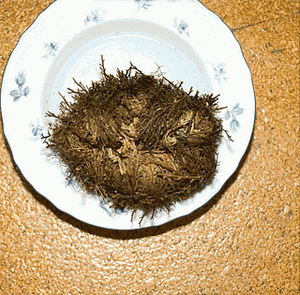Selaginella lepidophylla facts for kids
Quick facts for kids Selaginella lepidophylla |
|
|---|---|
 |
|
| Conservation status | |
| Scientific classification | |
| Synonyms | |
|
Lycopodium lepidophyllum |
Selaginella lepidophylla is a special desert plant. It belongs to the spikemoss family. People often call it a "resurrection plant". This is because it can survive almost completely drying out. Then, it comes back to life when it gets water.
These amazing plants can live through extreme dryness. They start their normal activities again when they get water. When it's dry, the plant's stems curl into a tight ball. They uncurl only when they find moisture. The plant can grow up to 5 centimeters tall. It lives naturally in the Chihuahuan Desert.
Contents
What are the Names for This Plant?
This plant has many interesting common names. Some of them are flower of stone, false rose of Jericho, rose of Jericho, resurrection plant, resurrection moss, and dinosaur plant. In Spanish, it's called siempre viva (which means "always alive") and doradilla.
It's important not to confuse Selaginella lepidophylla with another plant. The Anastatica hierochuntica is also called the "true Rose of Jericho." But it's a different kind of plant. Selaginella lepidophylla is a true resurrection plant. This means it can really revive and start living again after being very dry. The "true Rose of Jericho" is more like a tumbleweed. It can open and close, but it doesn't truly come back to life like Selaginella lepidophylla.
How Does This Plant Look and Act?
A cool thing about Selaginella lepidophylla is how it handles long dry periods. It has a special way to survive. When there's no water, it dries up and rolls inward. It forms a tight ball. This plant can live for several years like this. It can lose up to 95% of its water and still not be harmed.
When the air and ground get humid again, the plant "wakes up." Even if it has been dry for a long time, it can recover. It starts photosynthesis and grows again. When it's dry, its leaves become tough and brown.
The dry ball opens a few hours after it touches water. The dry leaves slowly turn green again. If its roots are not too damaged, the plant can survive. The plant can soak up water and unfold itself. It can do this even many years after it has died.
When there's no water, the plant goes into a sleepy state. It makes a special sugar called trehalose. This sugar helps protect its tissues and cells from damage while drying. When water evaporates, salts can build up in the plant. The trehalose acts like the water. It stops the salts from hurting the plant. This protects it from dying because of too much salt. S. lepidophylla also uses other substances called betaines. They work like trehalose.
Once the plant gets water, the sugar crystals dissolve. The plant's activities, which were paused, start again. Leaves that looked dead turn green and open up.
How Does This Plant Live?
Surviving in Desert Conditions
Selaginella lepidophylla is made for the desert. It can live without water for many years. It dries out until it only has 3% of its original weight. This plant can live and reproduce in dry places for a long time. When living conditions get too hard, the plant has a survival mechanism. It slowly dries out. Its leaves turn brown and fold in. This makes the plant look like a ball. When it's "sleeping," all its life functions slow down a lot.
What Happens During Long Dry Spells?
If the dry weather lasts a very long time, the plant's roots might break off. Then, the wind can carry the plant away. If it lands somewhere with moisture, Selaginella lepidophylla can get water again. It might even grow new roots in the new spot.
Not all resurrection plants can "rise again" every time. If they dry out too fast, or if it's dry and wet too often, the plant might not have enough time to get ready for the stress. Also, the ability to dry and rehydrate can get weaker over time. After many times of drying and growing, the plant might eventually die.
S. lepidophylla does not make flowers or seeds. It reproduces using spores. These plants are not water plants or plants that grow on other plants.
How Do People Use This Plant?
Selaginella lepidophylla is sold as a fun item. You can buy it dry. Then, you can add a little water to watch it come back to life.
Spanish missionaries noticed this plant's amazing ability when they came to the New World. They used S. lepidophylla to show people the idea of being "reborn." They hoped it would convince native people to change their beliefs. Because of its special qualities, the false rose of Jericho was seen as a lucky charm. Families would pass it down through generations.
People have also used Selaginella lepidophylla as a herbal medicine. They make a tea by soaking a spoonful of the dried plant in hot water. This tea is used to help with colds and sore throat.
In Mexico, S. lepidophylla is sold as a diuretic. This means it helps the body get rid of extra water. Women sometimes drink the water the plant is soaked in to help with childbirth. People believe that how fast the plant opens in the water can show if the birth will be easy or hard.
The plant is also used in some special ceremonies. For example, in Cuban Vodú and Cuban santería, it's used to bring love and good luck. Some people believe the plant can take away "negative energy" if worn on the body.
Gallery
See also
 In Spanish: Doradilla para niños
In Spanish: Doradilla para niños






